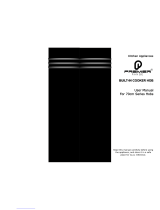
3
TECHNICAL INSTRUCTIONS AND INSTALLATION
• Installation of the appliance into a kitchen worktop and its connection to the power
mains and the gas supply may only be performed by an adequately qualified
technician.
• When the appliance is in use, additional heat and moisture are emitted into the
room. When the appliance is used for a prolonged period of time at a high
performance level, intensive ventilation or use of kitchen hood may is required in the
room where the appliance is installed.
• Do not use the gas burners, if the flame seems unstable.
• If you smell gas in the room, immediately close the gas supply valve either on the
gas bottle or gas pipeline, extinguish all sources of open fi re (including cigarettes),
aerate the room, do not turn on any electric appliances, and call a natural gas
expert.
• The main gas supply valve should also be closed if gas burners will be out of use
for a long period of time (e.g. when going on holiday).
• Do not leave small children unattended when the appliance is in operation. Risk of
burning and scalding!
• During cooking, the overheated fat or oil on the hob may ignite. There is a risk of
burning and fire; therefore, control the cooking process at all times.
• Do not use the cooking hob for room heating.
•Do not place empty pans on the hob.
• Make sure that the parts of the burners are correctly positioned / installed.
• Glass ceramic hobs should not be used as a worktop. Sharp objects may cause
scratches.
• Preparing food in thin aluminum of plastic containers on hot cooking zones is not
allowed. Do not place any plastic objects or aluminum foil on the glass ceramic hob.
• If there is a wall power outlet located near the hob and another appliance is
plugged into it, make sure the power cord does not come into contact with the hot
cooking zones.
• Do not store any temperature-sensitive objects, materials, or substances
underneath the hob, e.g. detergents, sprays, etc.
• Do not use the glass ceramic hob if it is cracked or broken. If any visible crack
appears, immediately unplug disconnect the appliance from the power supply to
avoid the possibility of electric shock.
• In case of a failure of the appliance, immediately disconnect the appliance from the
power mains and contact the service center.
• Do not use steam cleaners or high-pressure cleaners to clean the cooking hob, as
this may result in an electric shock.
• The appliance is manufactured in compliance with the relevant effective safety
standards.
• The appliance is not intended for use by persons (including children) with reduced
physical, sensory or mental capabilities, or lack of experience and knowledge, unless
they have been given supervision or instruction concerning use of the appliance by a
person responsible for they safety.
• Children should be supervised to ensure that they do not play with the appliance.
• After a prolonged use of cast iron plates, the area of the plate and the edge of the
cooking zone may discolour. Repair service is not covered by the warranty.
• The hob can not be activated by external timers or remote controls systems.
The symbol on the product or on its packaging indicates that this product may
not be treated as household waste. Instead it shall be handed over to the
applicable collection point for the recycling of electrical and electronic
equipment. By ensuring this product is disposed of correctly, you will help
prevent potential negative consequences for the environment and human
health, which could otherwise be caused by inappropriate waste handling of
thisproduct. For more detailed information about recycling of this product,
please contact your local city offi ce, your household waste disposal service
or the shop where you purchased the product.















